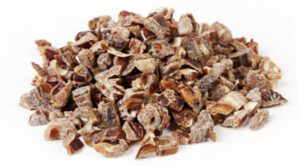Date chips are a healthy snack made from dried dates that have been sliced into thin pieces and often coated with a natural sweetener or seasoning. They are a convenient and tasty way to enjoy the nutritional benefits of dates and are a good alternative to traditional snack foods that are high in sugar and fat.
Here are some of the key properties of date chips:
1. Nutrient-dense: Date chips are a good source of fiber, vitamins, and minerals, including potassium, magnesium, and iron.
2. Low in fat: Date chips are naturally low in fat, making them a healthy snack option.
3. Natural sweetener: Dates are naturally sweet, so date chips can be a healthier alternative to traditional snacks that are high in added sugar.
4. Versatile: Date chips can be enjoyed as a snack on their own or used as a topping for yogurt, oatmeal, or smoothie bowls.
5. Convenient: Date chips are a convenient snack option that can be easily stored and transported.
6. Gluten-free: Date chips are naturally gluten-free, making them a good snack option for people with gluten sensitivities or celiac disease.
7. Energy booster: Date chips are a great source of natural energy and can help boost endurance and performance during physical activity.
In summary, date chips are a nutrient-dense snack that offer several health benefits. They are low in fat, a natural sweetener, versatile, convenient, gluten-free, and a great source of natural energy.
The Process of Making Date Chips
The process of making date chips involves several steps, including washing, slicing, drying, and seasoning the dates. Here is a brief overview of the process:
1. Washing: The first step is to wash the dates to remove any dirt or debris.
2. Slicing: Next, the dates are sliced into thin pieces using a sharp knife or a commercial slicer. The slices are usually uniform in size to ensure even drying.
3. Drying: The sliced dates are then dried in a dehydrator or an oven at a low temperature for several hours until they are crispy and dry. The drying process removes the moisture from the dates and helps to preserve them.
4. Seasoning: Once the dates are dried, they can be seasoned with various ingredients such as cinnamon, honey, or sea salt, depending on the desired flavor. The seasoning is usually added by tossing the date chips in a bowl with the seasoning until they are evenly coated.
5. Packaging: Finally, the date chips are packaged in airtight containers or bags to protect them from moisture and keep them fresh. The packaging is usually labeled with the product name, ingredients, nutritional information, and other relevant details.
In summary, making date chips involves washing, slicing, drying, and seasoning the dates. The process can be done at home using a dehydrator or oven or commercially using specialized equipment. The finished product is a healthy and convenient snack that can be enjoyed on its own or used as a topping for other foods.
Packaging and Exporting of Date Chips
Packaging and exporting are two crucial steps in the international trade of goods, including date chips. Here are some key aspects of packaging and exporting date chips:
Packaging:
1. Airtight containers: Date chips are packaged in airtight containers or bags to prevent moisture and air from entering, which can cause the product to spoil or lose its crispness.
2. Material: The packaging material used for date chips can vary, but it is often a food-grade plastic or paper that is sturdy and durable.
3. Labeling: The packaging is usually labeled with the product name, ingredients, nutritional information, and other relevant details. This information helps consumers make informed choices about the product and its contents.
4. Seal: The packaging should have a secure seal to prevent the product from spilling or leaking during transportation or storage.
5. Size: The size of the packaging can vary depending on the quantity of date chips inside. Smaller packages are suitable for individual portions, while larger packages are more suitable for sharing or for commercial use.
Exporting:
1. Regulations: Exporting date chips requires compliance with various regulations and customs procedures, including obtaining necessary permits and certificates, complying with labeling and packaging requirements, and adhering to import regulations in the destination country.
2. Transportation: Date chips are typically transported by air or sea, depending on the distance and destination. During transportation, it is essential to protect the containers from damage and extreme temperatures to prevent spoilage.
3. Quality control: Once the date chips reach the export location, they undergo a quality check to ensure that they meet the required standards and regulations. The product is then packed into larger containers, such as drums or barrels, for shipment to other countries.
4. Documentation: Exporting date chips requires a range of documentation, including commercial invoices, bills of lading, and customs declarations. These documents must be accurate and complete to ensure smooth customs clearance and delivery of the product.
In summary, packaging and exporting date chips involves careful handling and transportation to ensure that the product reaches its destination in good condition and complies with all regulations and standards. Proper packaging and documentation are essential to ensure that date chips remain fresh and retain their quality during transportation and storage.

